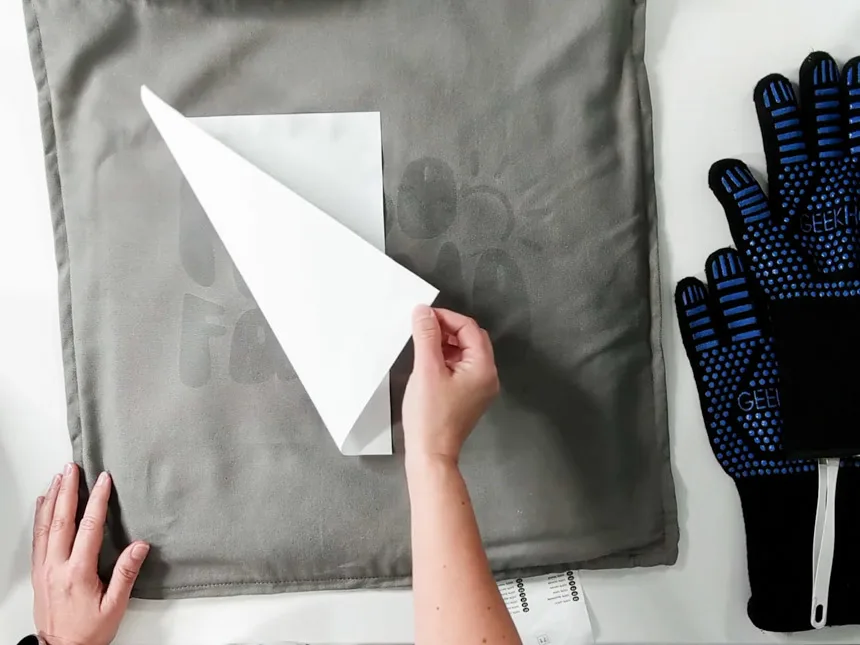By doing some research on the internet, you will find a multitude of products and techniques to remove heat transfer vinyl (Iron-On or HTV) from fabrics.
The result of all these techniques can really vary and depends on several factors:
- The type of heat transfer vinyl;
- The type of fabrics (cotton, etc.);
- The size of the design to be removed;
- and also how long the HTV has been installed.
You will understand that it is impossible for me to test everything and in all situations.
So, here are my experiments on my 100% cotton pillow with Cricut’s Iron-on vinyl that changes color under UV rays.
Materials and tools used in this tutorial
Remove heat transfer vinyl by heating the back
Yes, it is possible to remove HTV by heating the back with your press. Here’s how.
Protect your hands with heat-resistant gloves.
Put the press upside down and press the fabric on the hot plate.
In my case, since it is a pillow, I inserted the EasyPress inside.

To get the heat transfer vinyl to come off, I used the same temperature as for the installation. Here, as it was the Cricut Iron-on that changes color under UV rays, the temperature recommended by the Cricut Heat Guide was 315°F (155°C).
Just wait a few seconds to see the HTV wrinkle. Then, the pliers can be used to remove it.

It really comes off very easily.

Note that if you only have a small section to remove, the ideal would be to use a smaller press like the EasyPress mini.
Remove glue residue
Unfortunately, once the heat transfer vinyl is removed, there is still glue residue.

To remove the glue residues, I used photocopy paper (the most basic kind).

Simply place the sheets on top of the glue residue, put the press on top and heat as if installing HTV.
Again, I used the same temperature and time I had used to apply the Iron-on that changes under UV rays, which is the recommendation of the Cricut Heat Guide of 315°F (155°C) and 30 seconds.

Then remove the paper and continue on the remaining glue residue. Make sure you don’t reuse the same paper so you don’t reapply the glue to the fabric or even worse, to your press.

It is clear that the glue has transferred to the paper.

Note that I also tried this technique with parchment/parchment paper and that I had much less success! Copy paper is really much better.
Oh no, there’s still a halo!
Once all the HTV is removed, we can still see a halo of the design (like a shadow).

I initially thought it was glue so I continued my test. See at the bottom the result, because, in the end, it was not glue!
Remove heat transfer vinyl with Goo Gone
The Goo Gone was the only product I had on hand. It is a solvent for glue and adhesives and several articles on the internet recommended it.
Well, I’ll tell you right now: I don’t recommend it.
It is an extremely oily product and is perfect for non-porous surfaces. For fabrics, it’s a different story. My fabric also became oily and I was afraid that it would not go away after washing it. Besides, the halo was still there!
Remove Heat transfer vinyl with VLR
I wanted to continue with the VLR which is THE most recommended product for this (it is even written “letter removing solvent”)
But when I saw the price ($50 at that time) to do a simple test, I really hesitated. My pillow is a $5 IKEA pillow so buying a new one really made more sense!!!
So I thank my friend Cathy who lent me her big bottle of VLR to complete the test and come to a conclusion for you!
So I applied VLR to part of the halo of my cushion according to the manufacturer’s recommendations.
Nothing.
The halo was still there.
I started again leaving it longer.
Still nothing.
And that’s when I wondered if the halo was due to using my press. Could it be?
So I reapplied two rectangles of vinyl on the back of the cushion and left it for a few days.
I removed one with the warmth of my press and the other with the VLR.
In both cases, impeccable results! No halo, no glue residue (for the press I had to use the paper trick to remove glue residue as mentioned above).
And that’s WHEN I figured it out: my pillow stayed several weeks outside (partially in the sun) and the halo is simply due to the fact that the color of the pillow faded in the sun and everything under the vinyl did not fade (insert here a little emoji that taps its forehead!)
The best way to remove heat transfer vinyl
Again, results may vary depending on the HTV, the fabric used and the amount of time the HTV has been installed.
The conclusion of my tests is that the trick of using the press and copy paper is more than enough to remove the heat transfer vinyl or correct a small error. In my opinion, there is no need to use a chemical!
The problem is especially if you want to remove a piece of heat transfer vinyl that has been there for several days, weeks or even months! It must be assumed that the condition of the fabric will probably have changed and that you will probably see a demarcation.

Trudy
Tuesday 8th of August 2023
Thanks I will see if it works on a shirt or two, that I wanted to fix. When I do a new shirt I will use your technique if it gets messed up. You are a life saver, I hate wasting shirt or supplies.
Natalie
Thursday 10th of August 2023
I hate wasting things too! Glad I could help!